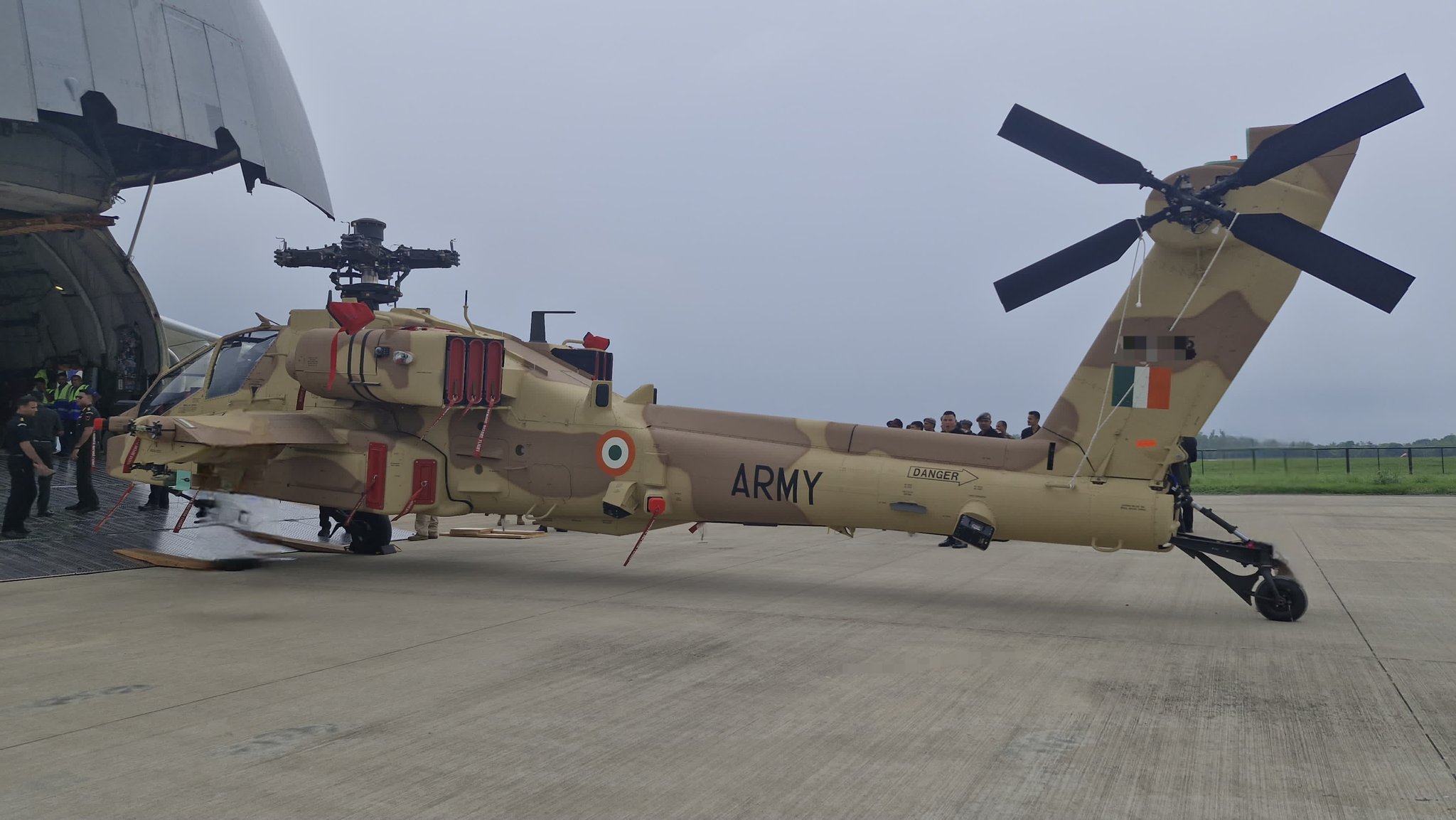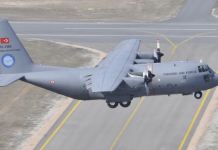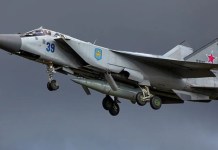After years of delays, the Indian Army was set to receive the second and final batch of Apache AH-64E helicopters from the United States. However, even though the helicopters were recently loaded onto an An-124 cargo aircraft for delivery, they never reached India.
The Indian Army inked a $600 million deal with the US in 2020 for six Apache AH-64E helicopters. The first batch of Apaches was initially scheduled to arrive in India by May-June 2024. Still, deliveries were repeatedly delayed due to supply chain disruptions, and the first batch finally arrived in the country in July 2025. The remaining three are due for delivery in November 2025, as reported earlier in the Indian media.
In line with this schedule, an Antonov Airlines An-124 cargo aircraft left the US for India, carrying three Apaches. However, in an unprecedented turn of events, the airplane reportedly turned back and landed in the US without any explanation.
@KiwaSpotter, who actively tracks airplanes noted on social media site X, noted that the heavy-lift An-124 serial UR-82008 took off from its operating base in Leipzig, Germany, and arrived at Mesa Gateway Airport, or the Phoenix–Mesa Airport, in Arizona, on October 30.
Antonov An-124 UR-82008 arrived at KIWA this afternoon from Leipzig, Germany, to pick up 3 AH-64E Apaches for the Indian Army. pic.twitter.com/5PNuAYGIcx
— KIWA Spotter (@KiwaSpotter) October 30, 2025
Photos of the helicopters being loaded onto the An-124 appeared on social media, showing the choppers with a camouflage scheme used by the Indian Army.
The helicopters finally departed the United States on November 1 and flew to East Midlands Airport in England. However, instead of flying onward to India, the An-124 loaded with Apaches spent eight days on the ground at the British airport.
The 3 Indian Army Apaches were returned back to KIWA today by the same An-124 that picked them up.
They never made it to India and instead spent 8 days at East Midlands Airport (EMA) in the UK before the An-124 brought them back. https://t.co/qgYgkhi8HH
— KIWA Spotter (@KiwaSpotter) November 9, 2025
Following this, the An-124 and its cargo flew back to the Mesa Gateway Airport, where they landed on November 8. Upon arrival, the Apaches were unloaded and later seen having their rotors removed. All three Apaches were towed away by the F250 trucks at the American airport.
New photos from KIWA show all 3 apache’s being towed away by 3 F250s@Adhyayan_S @KiwaSpotter pic.twitter.com/oKtECxP8Hd
— TSW1 (@TheShipWatch_1) November 10, 2025
The whole trail of events was documented by plane spotters, aviation enthusiasts, and OSINT analysts. A Boeing spokesperson told The War Zone that some “logistical issues” had interrupted the shipment, without elaborating.
The EurAsian Times has reached out to Boeing to further inquire about the exact nature of these logistical issues, and this report will be updated as and when we get a response.
Interestingly, the development comes even as Poland received two additional Apache AH-64D helicopters, as confirmed by the Polish Defense Minister Władysław Kosiniak-Kamysz on October 30.
Warsaw had earlier signed a deal to lease 8 of these gunship helos. “Two more Apache helicopters are already in the 1st Land Forces Aviation Brigade in #Inowroclaw – the last two will be delivered at the turn of the year,” he stated.
The aircraft carrying AH-64E choppers meant for the Indian Army being turned back is yet another snag in the delivery of the helicopters.
Another Hiccup In Apache Delivery To Indian Army
It is rather intriguing that, almost five years after the order for AH-64E Apache helicopters was placed, the delivery has not yet been completed.
The first batch of choppers, delivered earlier this year, is stationed at the first Apache rotary wing squadron, raised by the Indian Army in March 2024 in Jodhpur. “These … helicopters will enhance the Army Aviation wing’s operational effectiveness, especially in challenging terrains,” Defense Minister Rajnath Singh said after receiving the choppers.
The Indian Air Force (IAF) already operates 22 Apaches, also known as “Tank in the Air”. The IAF inducted the first batch of US-made Apache AH-64Es at the Pathankot Air Force Station and the second batch at Jorhat, Assam.
It was the second US-built helicopter to join the IAF’s fleet after the Chinook. The Indian Army, on its part, purchased the helicopter after the confrontation with China.
Boeing describes the AH-64E Apache helicopter as “an advanced multi-mission helicopter with the latest technology insertions, maintaining its standing as the world’s best attack helicopter. It is the only available combat helicopter with a spectrum of capabilities for virtually any mission requirement, including greater thrust and lift, joint digital operability, improved survivability, and cognitive decision aiding.”
The helicopter is designed to operate in mountainous terrain. It can conduct precision attacks at standoff ranges and operate in hostile airspace amid ground threats.
The Apache AH-64E is a fourth-generation, twin-engine, tandem-seat, heavily armed, all-weather, day/night, precision strike platform that can be deployed for a host of missions, including anti-armor, close air support (CAS), armed reconnaissance, and anti-ship roles.
The chopper’s avionics suite is state-of-the-art, centered on the Lockheed Martin Arrowhead third-generation forward-looking infrared (FLIR) system and the AN/APG-78 Longbow millimeter-wave fire-control radar mounted above the main rotor.

The Apaches are designed as “tank killers,” with Hellfire missiles capable of precision strikes against Pakistani or Chinese armored units in the event of a conflict. They can effectively engage 16 targets simultaneously with their Longbow radar, which can identify and prioritize up to 128 targets in under a minute, making them useful in situations requiring a quick reaction against PLA ground forces.
The AH-64E’s sophisticated sensors and targeting systems allow for day/night and all-weather missions, which are essential given the unpredictability of India’s volatile borders.
The IAF had deployed its Apaches in Ladakh during the 2020 tensions along the contested border, flying night sorties and demonstrating their utility.
The choppers are tailored for high-altitude operations, critical for India’s western border with Pakistan and for potential Himalayan deployments along the contested Line of Actual Control (LAC) near China, and feature Manned-Unmanned Teaming (MUM-T) for drone integration.
These choppers will complement the already inducted Apaches in the Indian Air Force’s (IAF) inventory. They enhance India’s ability to counter armored threats and provide close air support, especially in desert and semi-arid terrains.
Earlier, the Indian Ministry of Defense (MoD) stated in a press release that these helicopters can transmit and receive battlefield imagery via data networks.
Besides China, the Apaches are meant to bolster the Indian Army’s combat capability against Pakistan. These state-of-the-art helicopters are planned for deployment in the deserts, where they are best suited. In fact, this may be the biggest reason why the first unit was raised in Jodhpur.
Earlier, experts and veterans questioned the feasibility of purchasing new attack helicopters at a prohibitive cost, especially in an era when adversaries field portable air defense systems that put slow-moving helicopters at risk. Additionally, they argued that India should switch to drones, which are relatively cheaper than helicopters.
However, the utility of attack helicopters has been highlighted by a wide section of experts. For instance, IAF veteran Air Marshal Anil Chopra contends that attack helicopters are here to stay. “But the main reason attack helicopters will not disappear is that they fill a niche that very few platforms can fill. They are the only 350 KMPH missile carriers that can hide behind trees, pop up, and shoot and scoot,” he wrote in an article in the EurAsian Times.
- Contact the author at sakshi.tiwari13 (at) outlook.com
- Follow EurAsian Times on Google News




